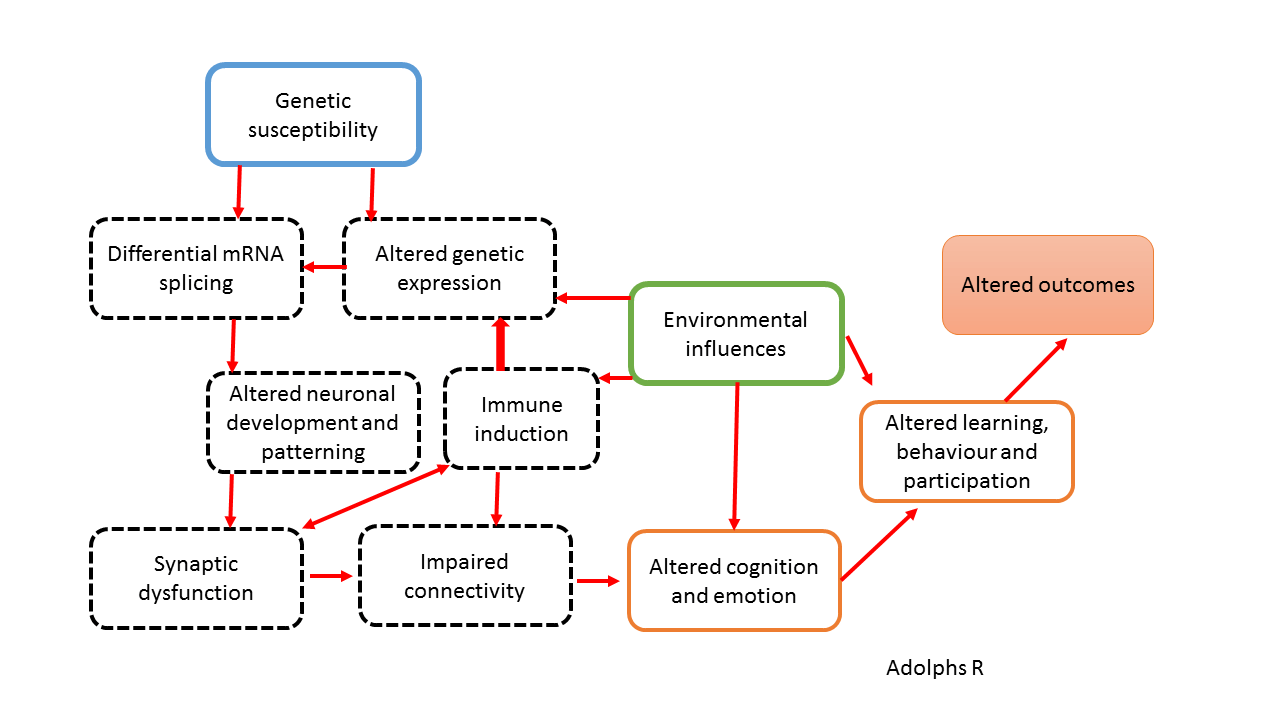Is there a gene for autism? If either the mother or the father has a relative with autism than can we say that autism comes from that side of the family? Is there going to be a genetic treatment for autism?
There is no doubt that autism is a highly genetic condition, beacuse:
- if there is one child with autism in a family, the chance of having another child with autism are 10 to 20 fold higher than a family with no child with autism[i]. Not every sibling of an autistic child will have autism, but the risk of recurrence of ASD in a sibling is much higher than in the general population. It is very difficult to estimate this risk accurately but from all the studies conducted so far the risk is about 10 to 25% or 1 in 10 to 1 in 4, depending on a number of factors. A good summary of the findings from the studies can be accessed here. The risk is higher for boys than girls.
- monozygotic twins (who share a placenta in the womb and all the genes), have 80-90% concordance rate (the chance of both twins having autism), compared to a 0-10% concordance rate in dizygotic twins (who like siblings in a family don’t share all the genes)[ii],[iii]. Also, worth looking at this paper to see the different levels of risks for other relatives.
It is worth remembering that while autism is highly genetic, it is not wholly genetic. The genetic contribution is 70-80%. That leaves a significant role for environment; how that role plays out is not yet fully understood.
Do we know which genes cause autism? The short answer is ‘no’. The massive amount of research done so far has indicated:
- A large number of genes, 200 to 1000 are likely to be involved[iv]
- These genes or, to be precise, genetic mutations or changes, are likely to interact with each other and with the environment to cause changes that lead to autism.
- While most genetic mutations or changes are carried in families and passed on by parents to the child, there are some that appear for the first time in a child (de novo) – there is no family history of autism in these families. Such cases account for less than 15% of individuals with ASD[v].
- No single gene has yet been identified that can on its own cause autism, most genes only add a small causal effect.
- Microscopically visible chromosomal alterations have been reported in fewer than 5% of individuals with ASD. The most frequent are located at chromosomal regions 2q37, 7q11, 15q11–13, 16p11, 22q11.2, and 22q13.3[vi].
- Rather than being “causal” the genes increase susceptibility or vulnerability to autism. This vulnerability, when combined with environmental factors and stressors (many deriving from either immune dysfunction in the mother or the fetus/neonate) mostly in prenatal and perinatal period, leads to the expression of autism[vii].
How do genes lead to ASD?

There is an emerging picture of the pathways through which genes result in ASD[viii],[ix]. In very broad terms the disrupted genetic expression, working in concert with environmental influences leads to impaired protein synthesis and immune function. There is widespread impact of this on neuronal development, neurotransmitters, synaptic structure and function, circuit miswiring due to difficulties with neuronal migration, axon pathfinding and synaptic function. This disruption is over the whole brain but is expressed more in some regions. The cognitive effects of this are also widespread affecting perception, processing and integration of information.
[i]Ozonoff S, Young GS, Carter A, Messinger D, Yirmiya N, et al. 2011. Recurrence risk for autism
spectrum disorders: a Baby Siblings Research Consortium study. Pediatrics 128:e488–95
[ii] Bailey A, Le Couteur A, Gottesman I, Bolton P, Simonoff E, et al. 1995. Autism as a strongly genetic
disorder: evidence from a British twin study. Psychol. Med. 25:63–77
[iii] Folstein S, Rutter M. 1977. Infantile autism: a genetic study of 21 twin pairs. J. Child Psychol. Psychiatry
18:297–321
[iv] Jason A. Chen, Olga Peñagarikano, T. Grant Belgard, Vivek Swarup and Daniel H. Geschwind. The Emerging Picture of Autism Spectrum Disorder: Genetics and Pathology. Annual Review of Pathology: Mechanisms of Disease. Vol. 10: 111-144
[v] Huguet, G., Ey, E., & Bourgeron, T. (2013). The genetic landscapes of autism spectrum disorders. Annual review of genomics and human genetics, 14, 191-213.
[vi] Microscopically visible chromosomal alterations have been reported in fewer than 5% of individuals
with ASD. The most frequent are located at chromosomal regions 2q37, 7q11, 15q11–13,
16p11, 22q11.2, and 22q13.3
[vii] Antar, L. N., Ferretti, C. J., & Hollander, E. (2012). Immune response and inflammation in autism spectrum disorder. Psychiatric Annals, 42(9), 342-346.
[viii] Geschwind, D. H. (2008). Autism: many genes, common pathways?. Cell, 135(3), 391-395.
[ix] Pinto, D., Delaby, E., Merico, D., Barbosa, M., Merikangas, A., Klei, L., … & Vorstman, J. A. (2014). Convergence of genes and cellular pathways dysregulated in autism spectrum disorders. The American Journal of Human Genetics, 94(5), 677-694.
Developmental regression<PREVIOUS PAGE NEXT PAGE>The Social Brain

